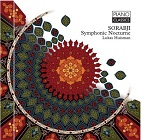Symphonic Nocturne
Lukas Huisman (piano)
Piano Classics: PCLD0119 (2016)
Web page for Piano Classics

Duration: 139:52
Track listing
- Track 1: Symphonic Nocturne (139:52)
Reviews
- “Further proof that Sorabji somehow managed simultaneously to adhere to one of the most instantly recognisable personal idioms in twentieth-century music while never coming close to repeating himself even in thousands of pages and repeated returns to a number of favourite genres and forms. The Symphonic Nocturne is a late work, from 1977-78, in the final phase of the composer’s career in the years following the self-imposed hiatus in the late 1960s which was broken by the astonishingly vigorous, fresh and youthful Symphonia brevis. The works of this late period tend to be somewhat sparer of texture as compared to the dense opulence of those from the 30s, 40s and 50s, and the composer’s “meta-tonality”, though a constant throughout his career, tends more toward triads with added-note dissonances than the harmonic density of earlier years, while retaining the inevitable, if often unpredictable, sense of harmonic direction that was always a driving force in his vocabulary. The work’s title is a little misleading to anyone expecting a huge (over two hours in this performance) ‘tropical nocturne’ of the Gulistān type; there is arguably more that is symphonic than nocturnal about much of the piece, especially as its argument progresses. The passages that are limned in the shades of night have less to do with the entangled vines and oppressive heat of the earlier nocturnes than a chilly, bleaker landscape; the direction ‘fosco’ – overcast, gloomy – is often to be found. The work has something in common with the large ‘intrecciata’ first movements of the piano symphonies, presenting a great many episodes of different material without adhering to particular forms that were explored in subsequent movements of multi-movement pieces. There are brief fugues and canons among the Symphonic Nocturne’s many episodes, but only en passant, so to speak. A better analogy might be a vast mosaic that, rather than having a symmetrical pattern, progresses in shape, size and design of tiles as one views it from one end to the other; the piece is in fact largely made up of small sections – a single system to a couple of pages at most – that follow a distinct trajectory (with many diversions along the way) toward a kind of ‘finale’, with successive volcanic climaxes finely calibrated to suggest a dramatic progression. This, and the work’s structuring not by large musical forms but (as the pianist points out in a perceptive analysis in the booklet) by numerological relationships which influence the listener’s perception of the work’s progress in the way that the proportions of the golden section make a painting pleasing to the eye, prevent any sense of diffuseness, a further tribute to Sorabji’s skill in maintaining a cogent argument over a very large span.” (Records International)
 Duration: 139:52
Duration: 139:52
